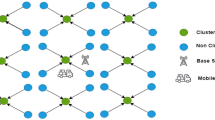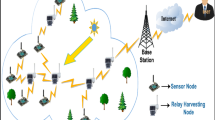Abstract
Scavenging energy from radio-frequency (RF) signals has drawn significant attention in recent years. By introducing the technology of RF energy harvesting into wireless sensor networks, a new type of network named mobile data gathering based wireless rechargeable sensor network (MGWRSN) is considered in this paper. In the MGWRSN, a dual-functional mobile sink (MS) which has the abilities of data collecting and RF energy generating is employed. Data sensed by sensor nodes is gathered at several selected head nodes (HNs). Through using the RF energy supplied by the MS, the HNs deliver the gathered data to the MS arriving at the corresponding rendezvous points (RPs). In our works, the network energy consumption model of the MGWRSN is built, and the energy efficient dispatch strategy for the MS is studied, aiming at cutting down the total network energy consumption. For the simplest case, i.e., the one-HN MGWRSN, the optimal location of the RP is provided to minimize the total network energy consumption. After that, the researches are extended into the case of multi-HN MGWRSN and a heuristic dispatch strategy named HEEDS is proposed. Theoretical analysis and numerical results show that: (1) in the one-HN MGWRSN, the optimal location of the RP is close related to the data bulk to be transmitted, the unit mobility energy cost, the required bit error rate, the modulation scheme, and the departure position of the MS; (2) comparing with the existing algorithm WRP which directly dispatches the MS to the locations of HNs to collect data, the proposed strategy HEEDS is shown to be more energy efficient. Moreover, when a high energy transfer power is available at the MS, HEEDS renders shorter packet delay compared to WRP.







Similar content being viewed by others
Notes
As mentioned in Sect. 2, the HNs are already given thus the information of HNs (e.g. the number and locations of HNs) is predetermined.
In our works, the data routing is constructed based on shortest-path-tree (SPT).
References
Tentzeris, M., Georgiadis, A., & Roselli, L. (2014). Energy harvesting and scavenging. Proceedings of the IEEE, 102(11), 1644–1648.
Zhang, Y., He, S., Chen, J., et al. (2013). Distributed sampling rate control for rechargeable sensor nodes with limited battery capacity. IEEE Transactions on Wireless Communications, 12(6), 3096–3106.
Colomer, J., Brufau, J., Miribel, P., et al. (2007). Novel autonomous low power VLSI system powered by ambient mechanical vibrations and solar cells for portable applications in a 0.13\(\mu \) technology. In Proceedings of the IEEE power electronics specialists conference, June 17–21, 2007.
Tan, Y. K., & Panda, S. K. (2011). Energy harvesting from hybrid indoor ambient light and thermal energy sources for enhanced performance of wireless sensor nodes. IEEE Transactions on Industrial Electronics, 58(9), 4424–4435.
Kim, S., Vyas, R., Bito, J., et al. (2014). Ambient RF energy-harvesting technologies for self-sustainable standalone wireless sensor platforms. Proceedings of the IEEE, 102(11), 1649–1666.
Zungeru, A. M., Ang, L. M., Prabaharan, S., et al. (2012). Radio frequency energy harvesting and management for wireless sensor networks. In Green mobile devices and networks: energy optimization and scavenging techniques (pp. 341–368). CRC Press.
Ajmal, T., Dyo, V., Allen, B., et al. (2014). Design and optimisation of compact RF energy harvesting device for smart applications. Electronics Letters, 50(2), 111–113.
Krikidis, I., Timotheou, S., & Sasaki, S. (2012). RF energy transfer for cooperative networks: Data relaying or energy harvesting. IEEE Communications Letters, 16(11), 1772–1775.
He, S., Chen, J., Jiang, F., et al. (2013). Energy provisioning in wireless rechargeable sensor networks. IEEE Transactions on Mobile Computing, 12(10), 1931–1942.
Cheng, P., He, S., Jiang, F., et al. (2013). Optimal scheduling for quality of monitoring in wireless rechargeable sensor networks. IEEE Transactions on Wireless Communications, 12(6), 3072–3084.
Ju, H., & Zhang, R. (2014). Throughput maximization in wireless powered communication networks. IEEE Transactions on Wireless Communications, 13(1), 418–428.
Fu, L., He, L., Cheng, P., et al. (2015). ESync: Energy synchronized mobile charging in rechargeable wireless sensor networks. IEEE Transactions on Vehicular Technology. doi:10.1109/TVT.2015.2481920.
Sample, A., Yaniel, D., Powledge, P., et al. (2008). Design of an RFID-based battery-free programmable sensing platform. IEEE Transactions on Instrumentation and Measurement, 57(11), 2608–2615.
Varshney, L. R. (2008). Transporting information and energy simultaneously. In Proceedings of the IEEE international symposium on information theory, July 6–11, 2008.
Park, J., & Clerckx, B. (2013). Joint wireless information and energy transfer in a two-user MIMO interference channel. IEEE Transactions on Wireless Communications, 12(8), 4210–4221.
Lee, S., Liu, L., & Zhang, R. (2015). Collaborative wireless energy and information transfer in interference channel. IEEE Transactions on Wireless Communications, 14(1), 545–557.
Salarian, H., Chin, K., & Naghdy, F. (2014). An energy-efficient mobile-sink path selection strategy for wireless sensor networks. IEEE Transactions on Vehicular Technology, 63(5), 2407–2419.
Liu, W., Lu, K., Wang, J., et al. (2012). Performance analysis of wireless sensor networks with mobile sinks. IEEE Transactions on Vehicular Technology, 61(6), 2777–2788.
Zhao, M., Yang, Y., & Wang, C. (2015). Mobile data gathering with load balanced clustering and dual data uploading in wireless sensor networks. IEEE Transactions on Mobile Computing, 14(4), 770–785.
Xie, L., Shi, Y., Hou, Y. T., et al. (2012). Making sensor networks immortal: An energy-renewal approach with wireless power transfer. EEE/ACM Transactions on Networking, 20(6), 1350–1358.
Wang, C., Li, J., Ye, F., & Yang, Y. (2014). NETWRAP: An NDN based real-time wireless recharging framework for wireless sensor networks. IEEE Transactions on Mobile Computing, 13(6), 1283–1297.
Heinzelman, W. B., Chandrakasan, A. P., & Balakrishnan, H. (2002). An application-specific protocol architecture for wireless microsensor networks. IEEE Transactions on Wireless Communications, 1(4), 660–670.
El-Moukaddem, F., Torng, E., Xing, G., & Kulkarni, S. (2013). Mobile relay configuration in data-intensive wireless sensor networks. IEEE Transactions on Mobile Computing, 2(12), 261–273.
Zhang, W., Duan, D., & Yang, L. (2011). Relay selection from a battery energy efficiency perspective. IEEE Transactions on Communications, 59(6), 1525–1529.
Tse, D., & Viswanath, P. (2005). Fundamentals of wireless communications. Cambridge: Cambridge University Press.
Zhou, X., Zhang, R., & Ho, C. K. (2013). Wireless information and power transfer: Architecture design and rate-energy tradeoff. IEEE Transactions on Communications, 61(11), 4754–4767.
Cormen, T. H., Cormen, C. E., Cormen, R. L., & Stein, C. (2001). Introduction to algorithms. Cambridge: MIT Press.
Powercast Corporation. (2015). TX91501 users’ manual. http://www.powercastco.com/products/powercaster-transmitters/.
Acknowledgments
This work was supported by National Natural Science Foundation of China (Grant Nos. 61125306, 91016004, 60974120), Guangxi Natural Science Foundation under Grant No. 2014GXNSFAA118373, the open fund of Key Laboratory of Measurement and Control of Complex Systems of Engineering, Ministry of Education under Grant No. MCCSE2013B01, and A Project Funded by the Priority Academic Program Development of Jiangsu Higher Education Institutions (PAPD).
Author information
Authors and Affiliations
Corresponding author
Rights and permissions
About this article
Cite this article
Li, X., Tang, Q. & Sun, C. Energy efficient dispatch strategy for the dual-functional mobile sink in wireless rechargeable sensor networks. Wireless Netw 24, 671–681 (2018). https://doi.org/10.1007/s11276-016-1363-3
Published:
Issue Date:
DOI: https://doi.org/10.1007/s11276-016-1363-3




